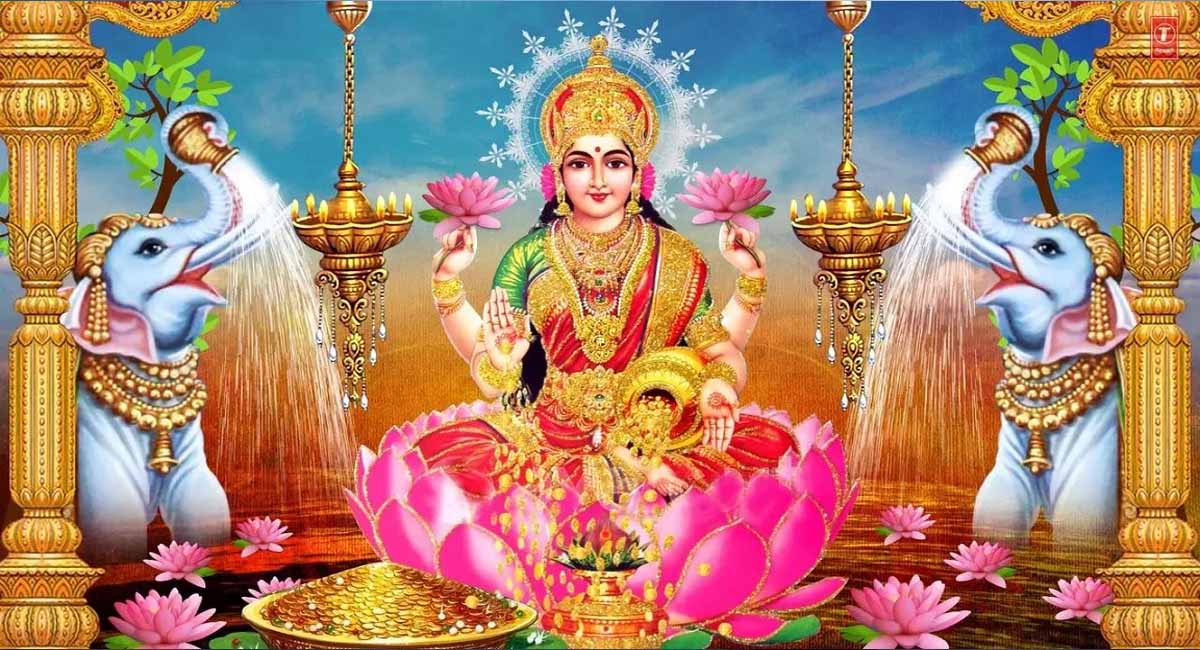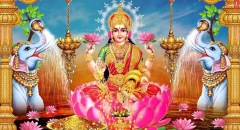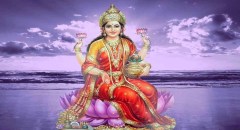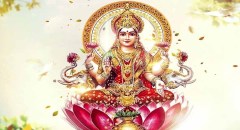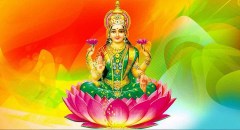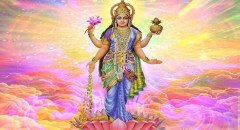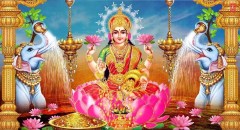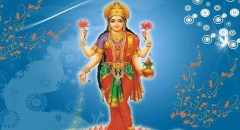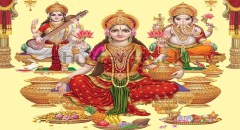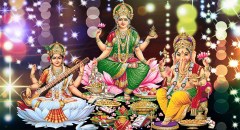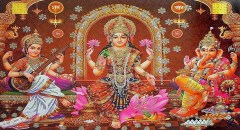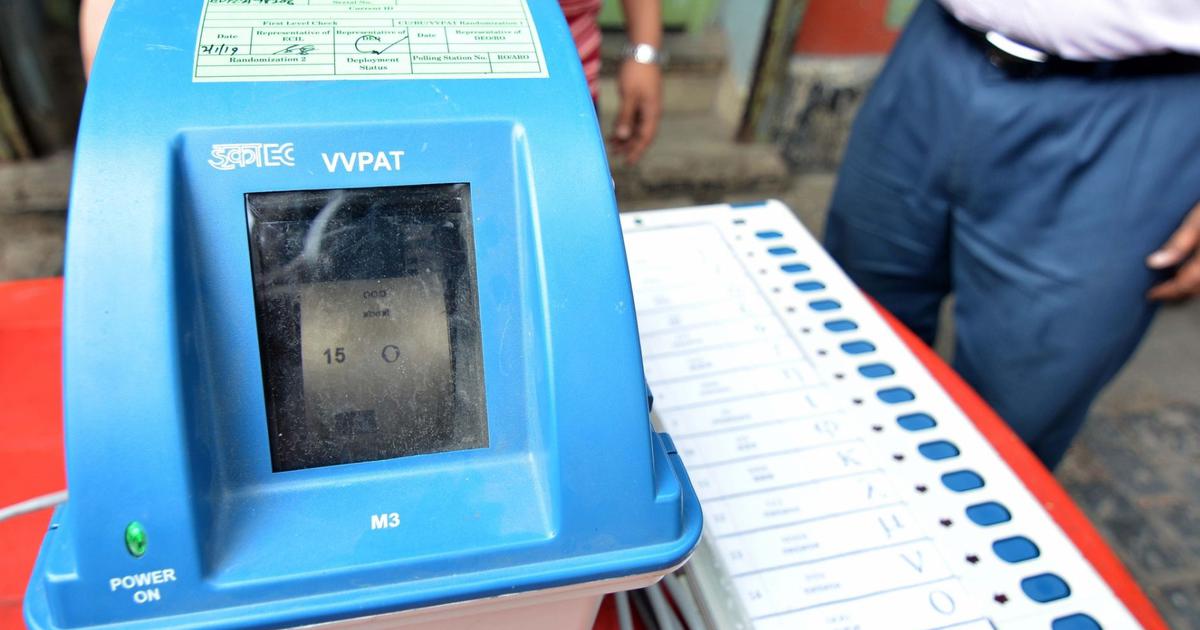Lakshmi Devi is a Hindu goddess who is believed to represent wealth, prosperity, and good fortune. She is also known as the goddess of abundance and fertility.
It is believed that Lakshmi Devi was born from the churning of the cosmic ocean and was chosen by the gods to be the wife of Lord Vishnu, one of the three main deities in Hinduism. Lakshmi Devi is often depicted holding a lotus flower in one hand, which symbolizes purity and enlightenment, and a pot of gold or coins in the other, which represents material wealth and prosperity.
Lakshmi Devi is worshipped during the festival of Diwali, which is known as the festival of lights and is celebrated in the autumn season. During this festival, people decorate their homes with lights and offer prayers and offerings to Lakshmi Devi to seek her blessings for wealth, prosperity, and happiness in their lives.
Lakshmi Devi is revered as a goddess of prosperity and abundance, and is believed to bring good fortune and success to those who seek her blessings.
Origin of Lakshmi Mata
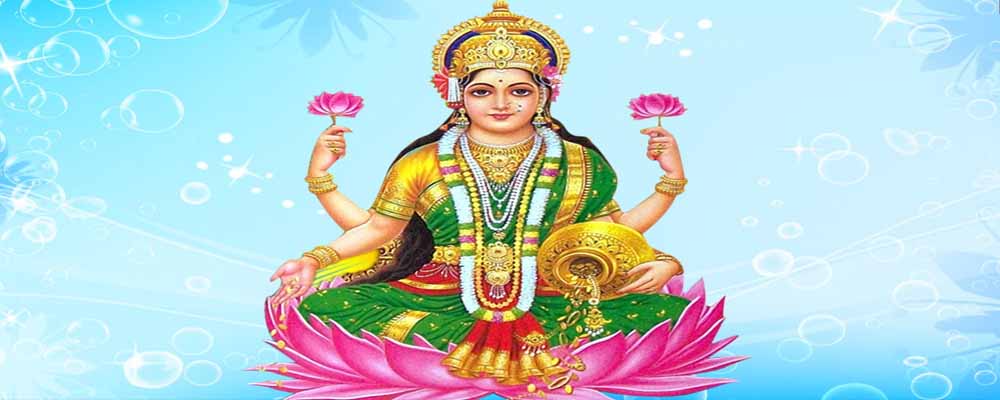
The origin of Lakshmi Devi can be traced back to Hindu mythology, where she is believed to have been born during the churning of the cosmic ocean, a mythological event that took place in order to obtain the nectar of immortality. According to the myth, the gods and demons churned the ocean with the help of a serpent called Vasuki, which was used as a rope, and Mount Mandara, which was used as a churn.
As the churning continued, various celestial beings and objects emerged from the ocean, including Lakshmi Devi, who is believed to have been one of the last to appear. It is said that as soon as Lakshmi Devi emerged from the ocean, she was immediately chosen by the gods to be the consort of Lord Vishnu, one of the three main deities in Hinduism.
Since then, Lakshmi Devi has been revered as a goddess of wealth, prosperity, and good fortune, and is often depicted as a beautiful woman with golden skin, dressed in rich garments and adorned with jewels. She is also associated with the lotus flower, which is considered a symbol of purity and enlightenment, and is often depicted holding a lotus flower in one hand.
In Hindu culture, Lakshmi Devi is worshipped during various festivals and auspicious occasions, and is believed to bless her devotees with wealth, prosperity, and happiness. Overall, Lakshmi Devi holds a significant place in Hindu mythology and is revered as a goddess of abundance and fertility.
Lakshmi Mata Aarti
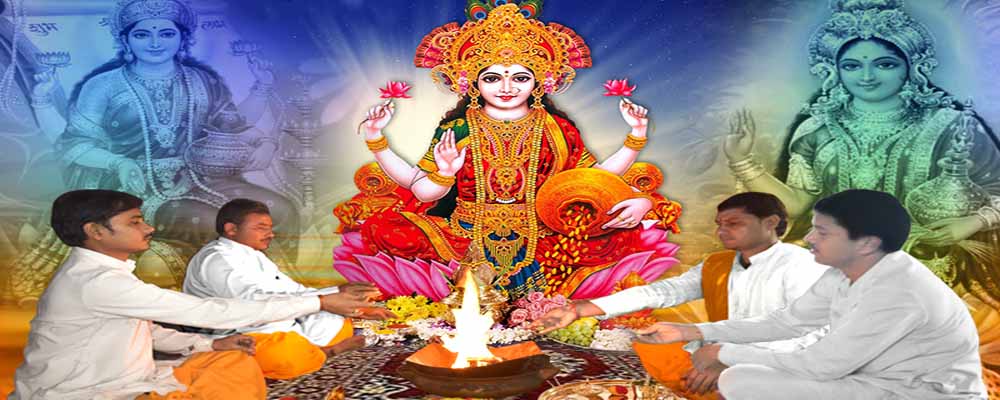
Lyrics of Lakshmi Mata Aarti
Om Jai Lakshmi Mata, Maiya Jai Lakshmi Mata,
Tumko Nishdin Sevat, Tumko Nishdin Sevat,
Har Vishnu Vidhata, Om Jai Lakshmi Mata
Uma Rama Bharmani, Tum Hi Jag Mata,
maiyya tum hi jag mata
Surya Chandrma Dhyavat, Surya Chandrma Dhyavat
Naarad Rishee Gata.
Om Jai Lakshmi Mata
Durga Roop Niranjani, Sukh Sampati Data,
maiyya sukh sampati data
Jo Koi Tum Ko Dhayata, Jo Koi Tum Ko Dhayata
Riddhi Siddhi Pata.
Om Jai Lakshmi Mata
Tum Patal Nivasini, Tum Hi Shubh Data,
maiyya tum hi subh data
Karam-Prabhav-Prakashini, Karam-Prabhav-Prakashini
Bhav Nidhi Ki Trata.
Om Jai Lakshmi Mata
Jis Ghar Mein Tum Rahti, Sab Sadgun Aata,
maiyya sab sadgun aata
Sab Sambhav Ho Jata, Sab Sambhav Ho Jata
Man Nahi Ghabrata.
Om Jai Lakshmi Mata
Tum Bin Yagya Na Hove, Vastra No ho Pata,
maiyya vastra na ho pata
Khan-Pana Ka Vaibhav, Khan-Pana Ka Vaibhav
Sub Tumse aata.
Om Jai Lakshmi Mata
Shubhgun Mandir Sundar, Sheerodadhi Jata,
maiyya Sheerodadhi Jata,
Ratan Chaturdhsh Tum Bin, Ratan Chaturdhsh Tum Bin
Koi Nahi Pata.
Om Jai Lakshmi Mata
Shri lakshmi Ji Ki Aarti, Jo Koi Nar Gata,
maiyya Jo Koi Nar Gata
Urr Anand Samata, Urr Anand Samata
Pap Utar Jata.
Om Jai Lakshmi Mata
Om Jai Lakshmi Mata, Maiya Jai Lakshmi Mata,
Tumko Nishdin Sevat, Tumko Nishdin Sevat,
Har Vishnu Vidhata.
Om Jai Lakshmi Mata
Steps for Lakshmi Mata Aarti
| Steps for Lakshmi Mata Aarti | Description |
|---|---|
| Purify the surroundings | Before starting the aarti, purify the surroundings by cleaning the puja area and lighting incense. |
| Light the lamp | Light a lamp or diya with ghee or oil. The light represents knowledge and wisdom. |
| Ring the bell | Ring a bell to signify the start of the aarti. The sound of the bell is believed to ward off evil spirits. |
| Chant the aarti | Chant the aarti, which is a devotional song praising Goddess Lakshmi. The aarti is usually sung in a group or by a single person. |
| Offer flowers | Offer fresh flowers to the goddess while singing the aarti. Flowers are considered a symbol of purity and devotion. |
| Offer incense | Offer incense sticks while singing the aarti. The fragrance of the incense is believed to purify the surroundings and create a divine atmosphere. |
| Offer sweets and fruits | Offer sweets like ladoo, peda, and modak, as well as fruits like bananas, apples, and pomegranates to the goddess. These offerings symbolize abundance and prosperity. |
| Circulate the aarti | After the aarti is over, circulate the lamp among the participants. This is believed to share the blessings of the goddess with everyone present. |
| Seek blessings | Seek blessings from the goddess and pray for prosperity and happiness in life. |
Lakshmi Mata Stories
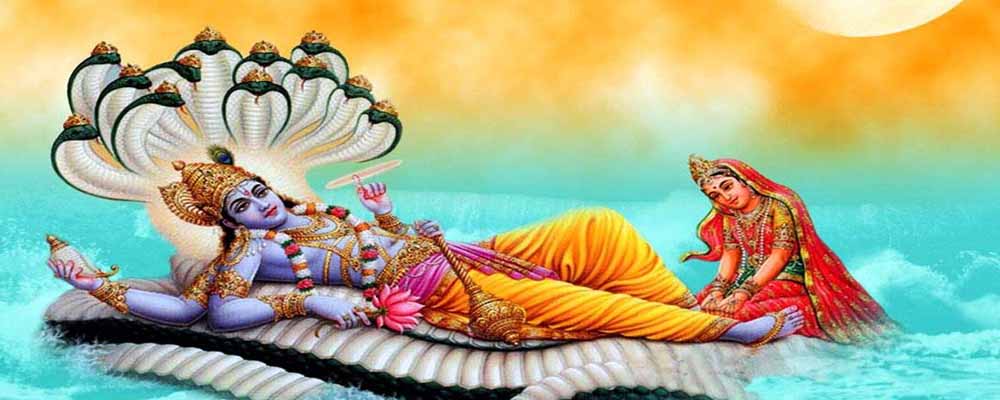
There are several stories associated with Lakshmi Devi in Hindu mythology, each highlighting different aspects of her personality and powers.
The Churning of the Ocean: As mentioned earlier, Lakshmi Devi is believed to have been born during the churning of the cosmic ocean. According to the myth, the gods and demons churned the ocean to obtain the nectar of immortality, and various celestial beings and objects emerged from the ocean as a result. Lakshmi Devi emerged last and was chosen by the gods to be the wife of Lord Vishnu.
The Story of King Bali: In this story, Lakshmi Devi appears in the form of a poor woman seeking charity from the demon king Bali. Bali, who was known for his generosity, agrees to grant her a wish, and she asks him to restore Lord Vishnu to his rightful place in heaven. Bali grants her wish, and Lord Vishnu returns to heaven, while Devi Lakshmi stays with Bali as his protector and advisor.
The Story of Raja Sudarshan: In this story, Devi Lakshmi appears to Raja Sudarshan, a poor and pious king, and asks him to perform a yagna to please the gods. Raja Sudarshan does as she asks, and as a result, he is blessed with wealth and prosperity.
The Story of Samudra Manthan: This is another story related to the churning of the ocean, in which Devi Lakshmi appears again. In this story, the gods and demons churned the ocean to obtain the nectar of immortality, but instead, they first obtained various other treasures, including Devi Lakshmi herself, who emerged from the ocean and became the consort of Lord Vishnu.
Lakshmi Devi Symbols
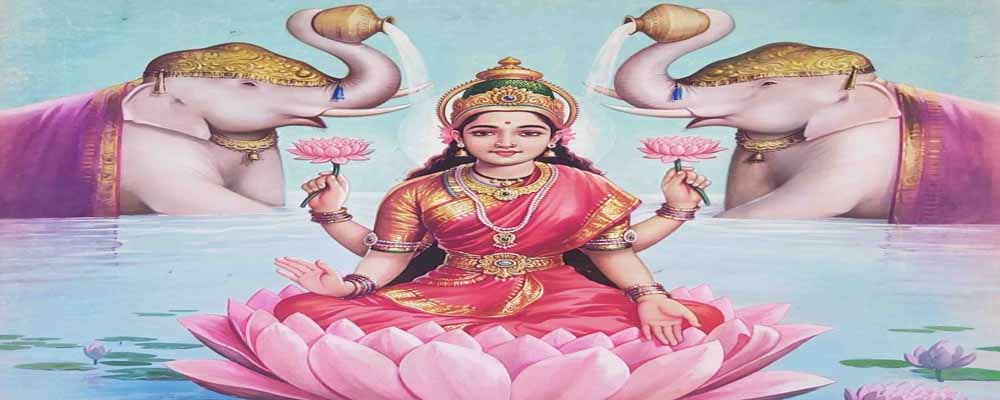
Lakshmi Devi, the Hindu goddess of wealth, prosperity, and good fortune, is associated with several symbols in Hindu mythology.
Lotus: The lotus flower is one of the most significant symbols associated with Lakshmi Devi. It is considered a symbol of purity, enlightenment, and spiritual growth, and is often depicted in Devi Lakshmi’s iconography. Devi Lakshmi is also known as Padma, which means lotus, and is often depicted holding a lotus flower in one of her hands.
Gold and Wealth: Lakshmi Devi is also associated with material wealth and prosperity. In her iconography, she is often depicted holding a pot of gold or a bag of money, which represents wealth and abundance. She is also associated with the color gold, which is considered a symbol of wealth and prosperity in Hindu culture.
Elephant: Lakshmi Devi is sometimes depicted sitting on a lotus flower with an elephant standing beside her. The elephant is considered a symbol of strength, stability, and prosperity in Hindu mythology, and is often associated with Devi Lakshmi.
Diya: A diya, or oil lamp, is also a significant symbol associated with Lakshmi Devi. During the festival of Diwali, which is celebrated in honor of Lakshmi Devi, people light diyas in their homes and temples to invite her blessings of wealth and prosperity.
Conch Shell: The conch shell is also a symbol associated with Lakshmi Devi. It is believed to represent the primordial sound of creation and is often used in Hindu rituals and ceremonies.
These symbols associated with Devi Lakshmi highlight her role as a goddess of wealth, prosperity, and good fortune, and her association with purity, enlightenment, and spiritual growth.
Lakshmi Devi Puja
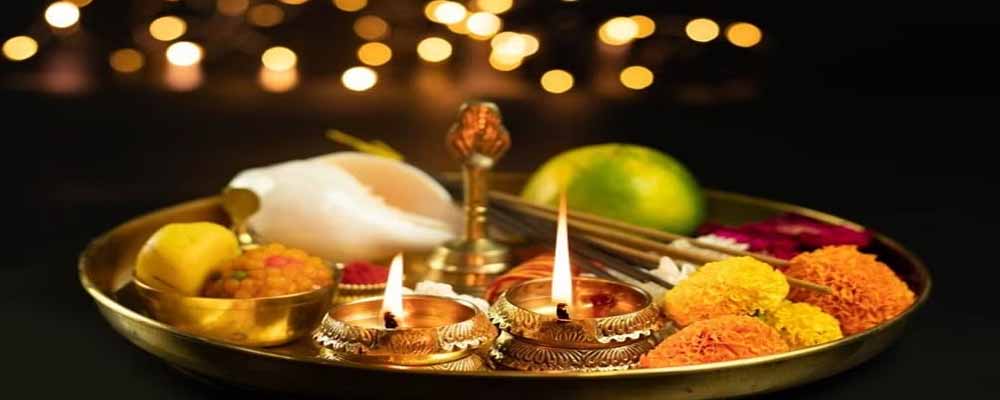
| Steps of Lakshmi Puja | Description |
|---|---|
| Sankalp | This is the first step where the devotee takes a vow to perform the puja with devotion and dedication. |
| Ganesha Puja | Lord Ganesha is worshipped before starting any auspicious ceremony, and this puja is performed to seek his blessings for the successful completion of the Lakshmi Puja. |
| Kalash Puja | The Kalash symbolizes Goddess Lakshmi and is worshipped during the puja. The Kalash is decorated with flowers, rice, and a coconut, and a red or yellow thread is tied around it. |
| Lakshmi Puja | This is the main part of the puja where Goddess Lakshmi is worshipped with flowers, incense, and a lamp. Devotees offer sweets, fruits, and other delicacies to the goddess as a sign of their devotion. |
| Aarti | The puja is concluded with the singing of an Aarti, which is a devotional song in praise of Goddess Lakshmi. The Aarti is usually accompanied by the ringing of bells and the burning of camphor. |
| Prasad Distribution | The devotees distribute the Prasad, which is the food offered to the Goddess during the puja, to all the participants as a blessing from the Goddess. |
Note: This is just an example, and there may be variations in the steps depending on the specific traditions and customs followed by different regions and communities.
Lakshmi Mata Mantras
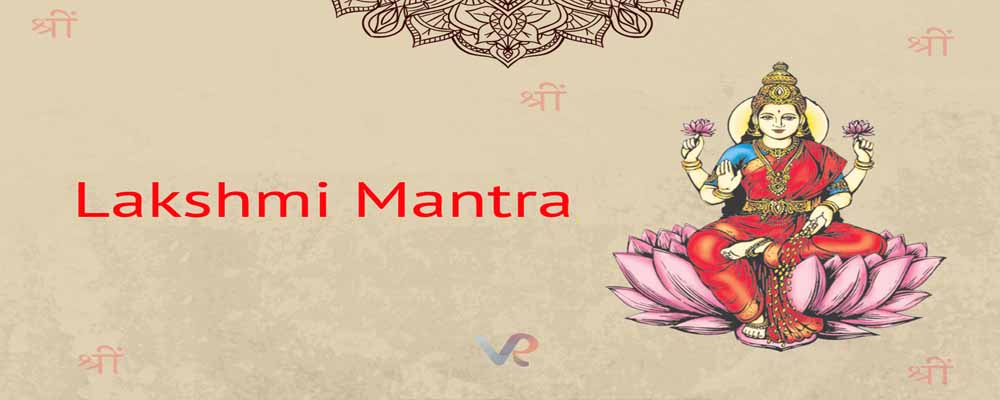
Devi Lakshmi is a popular goddess in Hinduism, and there are several mantras dedicated to her.
- Om Shreem Hreem Shreem Kamale Kamalalaye Praseed Praseed, Om Shreem Hreem Shreem Mahalakshmaye Namaha: This is a powerful mantra dedicated to Devi Lakshmi, and it is believed to attract wealth, prosperity, and good fortune. It is often recited during Lakshmi puja or during other auspicious occasions.
- Om Sarvabaadhaa Vinirmukto, Dhan Dhaanyah Sutaanvitah Manushyo Matprasaaden Bhavishyati Na Sanshayah: This mantra is believed to remove obstacles and bring wealth, prosperity, and good fortune. It is often recited during Lakshmi puja or other auspicious occasions.
- Om Hreem Shreem Lakshmibhyo Namah: This is a simple and powerful mantra dedicated to Devi Lakshmi, and it is believed to attract wealth, prosperity, and good fortune. It can be recited daily during meditation or during Lakshmi puja.
- Om Aim Hreem Shreem Sri Lalita Tripurasundari Padukam Poojayami Namah: This is a powerful mantra dedicated to Devi Lalita Tripurasundari, who is considered to be an aspect of Devi Lakshmi. It is believed to bring abundance, wealth, and happiness.
- Om Sri Maha Lakshmiyai Namah: This is a simple mantra that can be recited to invoke the blessings of Lakshmi Devi. It is believed to bring wealth, prosperity, and good fortune.
These mantras dedicated to Devi Lakshmi are believed to bring wealth, prosperity, and good fortune, and they can be recited during meditation, Lakshmi puja, or other auspicious occasions.
Lakshmi Devi Offerings
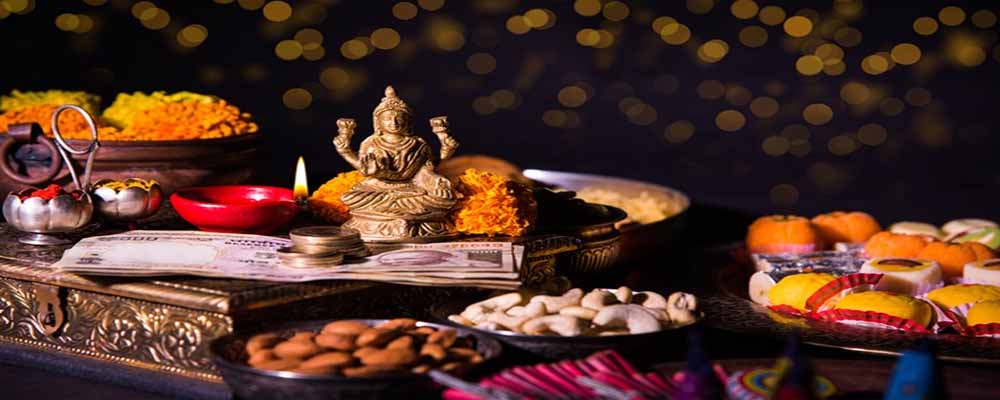
| Offerings | Description |
|---|---|
| Flowers | Fresh flowers like marigold, lotus, and roses are offered to the goddess. They are a symbol of purity and devotion. |
| Incense | Burning incense sticks or agarbattis during the puja is common. The fragrance is believed to purify the surroundings and create a divine atmosphere. |
| Lamp or Diya | Lighting a lamp or diya is an essential part of the puja. The light represents knowledge and dispels darkness. A ghee lamp is considered more auspicious. |
| Sweets and Fruits | Offer sweets like ladoo, peda, and modak, as well as fruits like bananas, apples, and pomegranates to the goddess. These offerings symbolize abundance and prosperity. |
| Rice and Grains | Offer rice and grains like wheat, barley, and lentils to the goddess. These offerings symbolize a bountiful harvest and abundance. |
| Mantra Book | Offer a book containing the mantras and slokas dedicated to Goddess Lakshmi. This offering is believed to please the goddess and invite her blessings. |
Note: This is just an example, and there may be variations in the offerings depending on the specific traditions and customs followed by different regions and communities.
Lakshmi Mata Photo 2023
FAQs about Lakshmi Devi
Who is Lakshmi Devi?
Lakshmi Devi is a Hindu goddess of wealth, fortune, and prosperity. She is often worshipped by devotees seeking material and spiritual abundance in their lives.
What are the 10 avatars of Lakshmi?
1. Dhana Lakshmi – Goddess of Wealth
2. Dhairya Lakshmi – Goddess of Courage
3. Santana Lakshmi – Goddess of Progeny
4. Gaja Lakshmi – Goddess of Elephants and Strength
5. Vijaya Lakshmi – Goddess of Victory
6. Vidya Lakshmi – Goddess of Knowledge and Learning
7. Adi Lakshmi – Primeval Goddess
8. Dhanya Lakshmi – Goddess of Agriculture and Harvest
9. Veera Lakshmi – Goddess of Bravery and Valor
10. Varalakshmi – Goddess who grants boons
Who is Lakshmi Devi husband?
In Hindu mythology, Lakshmi Devi is married to Lord Vishnu, who is considered to be the preserver of the universe.
Does Lakshmi get angry?
Lakshmi Devi is generally portrayed as a goddess of wealth, prosperity, and good fortune, and is not usually associated with anger. However, like all deities in Hindu mythology, she has different aspects and can manifest in various forms.
Who gave birth to Lakshmi?
There are different versions of the mythological story of Lakshmi’s birth. In one version, she emerges from the ocean of milk (Samudra Manthan) during the churning of the ocean by the gods and demons. In another version, she is born as the daughter of the sage Bhrigu and his wife Khyati. In yet another version, she is the daughter of the god Dharma and his wife Sri.
